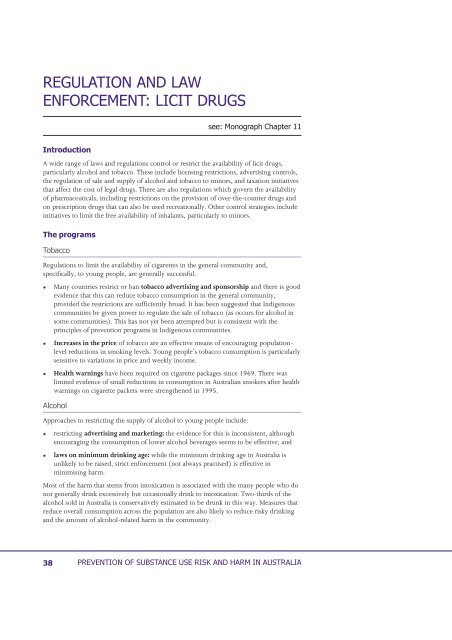Summary - Department of Health and Ageing
Summary - Department of Health and Ageing
Summary - Department of Health and Ageing
Create successful ePaper yourself
Turn your PDF publications into a flip-book with our unique Google optimized e-Paper software.
A wide range <strong>of</strong> laws <strong>and</strong> regulations control or restrict the availability <strong>of</strong> licit drugs,<br />
particularly alcohol <strong>and</strong> tobacco. These include licensing restrictions, advertising controls,<br />
the regulation <strong>of</strong> sale <strong>and</strong> supply <strong>of</strong> alcohol <strong>and</strong> tobacco to minors, <strong>and</strong> taxation initiatives<br />
that affect the cost <strong>of</strong> legal drugs. There are also regulations which govern the availability<br />
<strong>of</strong> pharmaceuticals, including restrictions on the provision <strong>of</strong> over-the-counter drugs <strong>and</strong><br />
on prescription drugs that can also be used recreationally. Other control strategies include<br />
initiatives to limit the free availability <strong>of</strong> inhalants, particularly to minors.<br />
<br />
<br />
Regulations to limit the availability <strong>of</strong> cigarettes in the general community <strong>and</strong>,<br />
specifically, to young people, are generally successful.<br />
<br />
<br />
<br />
Many countries restrict or ban tobacco advertising <strong>and</strong> sponsorship <strong>and</strong> there is good<br />
evidence that this can reduce tobacco consumption in the general community,<br />
provided the restrictions are sufficiently broad. It has been suggested that Indigenous<br />
communities be given power to regulate the sale <strong>of</strong> tobacco (as occurs for alcohol in<br />
some communities). This has not yet been attempted but is consistent with the<br />
principles <strong>of</strong> prevention programs in Indigenous communities.<br />
Increases in the price <strong>of</strong> tobacco are an effective means <strong>of</strong> encouraging populationlevel<br />
reductions in smoking levels. Young people’s tobacco consumption is particularly<br />
sensitive to variations in price <strong>and</strong> weekly income.<br />
<strong>Health</strong> warnings have been required on cigarette packages since 1969. There was<br />
limited evidence <strong>of</strong> small reductions in consumption in Australian smokers after health<br />
warnings on cigarette packets were strengthened in 1995.<br />
<br />
Approaches to restricting the supply <strong>of</strong> alcohol to young people include:<br />
<br />
<br />
restricting advertising <strong>and</strong> marketing: the evidence for this is inconsistent, although<br />
encouraging the consumption <strong>of</strong> lower alcohol beverages seems to be effective; <strong>and</strong><br />
laws on minimum drinking age: while the minimum drinking age in Australia is<br />
unlikely to be raised, strict enforcement (not always practised) is effective in<br />
minimising harm.<br />
Most <strong>of</strong> the harm that stems from intoxication is associated with the many people who do<br />
not generally drink excessively but occasionally drink to intoxication. Two-thirds <strong>of</strong> the<br />
alcohol sold in Australia is conservatively estimated to be drunk in this way. Measures that<br />
reduce overall consumption across the population are also likely to reduce risky drinking<br />
<strong>and</strong> the amount <strong>of</strong> alcohol-related harm in the community.

















